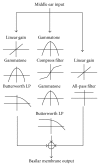Fatigue Modeling via Mammalian Auditory System for Prediction of Noise Induced Hearing Loss
- PMID: 26691685
- PMCID: PMC4672119
- DOI: 10.1155/2015/753864
Fatigue Modeling via Mammalian Auditory System for Prediction of Noise Induced Hearing Loss
Abstract
Noise induced hearing loss (NIHL) remains as a severe health problem worldwide. Existing noise metrics and modeling for evaluation of NIHL are limited on prediction of gradually developing NIHL (GDHL) caused by high-level occupational noise. In this study, we proposed two auditory fatigue based models, including equal velocity level (EVL) and complex velocity level (CVL), which combine the high-cycle fatigue theory with the mammalian auditory model, to predict GDHL. The mammalian auditory model is introduced by combining the transfer function of the external-middle ear and the triple-path nonlinear (TRNL) filter to obtain velocities of basilar membrane (BM) in cochlea. The high-cycle fatigue theory is based on the assumption that GDHL can be considered as a process of long-cycle mechanical fatigue failure of organ of Corti. Furthermore, a series of chinchilla experimental data are used to validate the effectiveness of the proposed fatigue models. The regression analysis results show that both proposed fatigue models have high corrections with four hearing loss indices. It indicates that the proposed models can accurately predict hearing loss in chinchilla. Results suggest that the CVL model is more accurate compared to the EVL model on prediction of the auditory risk of exposure to hazardous occupational noise.
Figures









Similar articles
-
Contribution of animal studies to our understanding of impulse noise induced hearing loss.Scand Audiol Suppl. 1980 Aug;(Suppl 12):128-46. Scand Audiol Suppl. 1980. PMID: 6939081 No abstract available.
-
Insights into hazard from intense impulses from a mathematical model of the ear.J Acoust Soc Am. 1991 Jul;90(1):219-27. doi: 10.1121/1.401291. J Acoust Soc Am. 1991. PMID: 1880292
-
Effects of noise on inferior colliculus evoked potentials and cochlear anatomy in young and aged chinchillas.Hear Res. 1998 Mar;117(1-2):81-96. doi: 10.1016/s0378-5955(98)00013-6. Hear Res. 1998. PMID: 9557979
-
Analytical and numerical modeling of the hearing system: Advances towards the assessment of hearing damage.Hear Res. 2017 Jun;349:111-128. doi: 10.1016/j.heares.2017.01.015. Epub 2017 Feb 2. Hear Res. 2017. PMID: 28161584 Free PMC article. Review.
-
Modeling the interactions between noise exposure and other variables.J Acoust Soc Am. 1991 Jul;90(1):182-8. doi: 10.1121/1.401286. J Acoust Soc Am. 1991. PMID: 1880287 Review.
Cited by
-
Prevention of Noise-Induced Hearing Loss from Recreational Firearms.Semin Hear. 2017 Nov;38(4):267-281. doi: 10.1055/s-0037-1606323. Epub 2017 Oct 10. Semin Hear. 2017. PMID: 29026261 Free PMC article. Review.
-
Toward a Reasoned Classification of Diseases Using Physico-Chemical Based Phenotypes.Front Physiol. 2018 Feb 28;9:94. doi: 10.3389/fphys.2018.00094. eCollection 2018. Front Physiol. 2018. PMID: 29541031 Free PMC article.
-
Bioprosthetic aortic valve diameter and thickness are directly related to leaflet fluttering: Results from a combined experimental and computational modeling study.JTCVS Open. 2021 Jun;6:60-81. doi: 10.1016/j.xjon.2020.09.002. Epub 2020 Sep 21. JTCVS Open. 2021. PMID: 35211686 Free PMC article.
References
-
- Agrawal Y., Platz E. A., Niparko J. K. Prevalence of hearing loss and differences by demographic characteristics among US adults: data from the National Health and Nutrition Examination Survey, 1999–2004. Archives of Internal Medicine. 2008;168(14):1522–1530. doi: 10.1001/archinte.168.14.1522. - DOI - PubMed
-
- International Organization for Standardization. Acoustics—Estimation of Noise-Induced Hearing Loss. Geneva, Switzerland: International Organization for Standardization; 2013.
-
- Institute A. N. S. American national standard determination of occupational noise exposure and estimation of noiseinduced hearing impairment (ansi s3. 44–1996) 1996.
Publication types
MeSH terms
Grants and funding
LinkOut - more resources
Full Text Sources
Other Literature Sources

